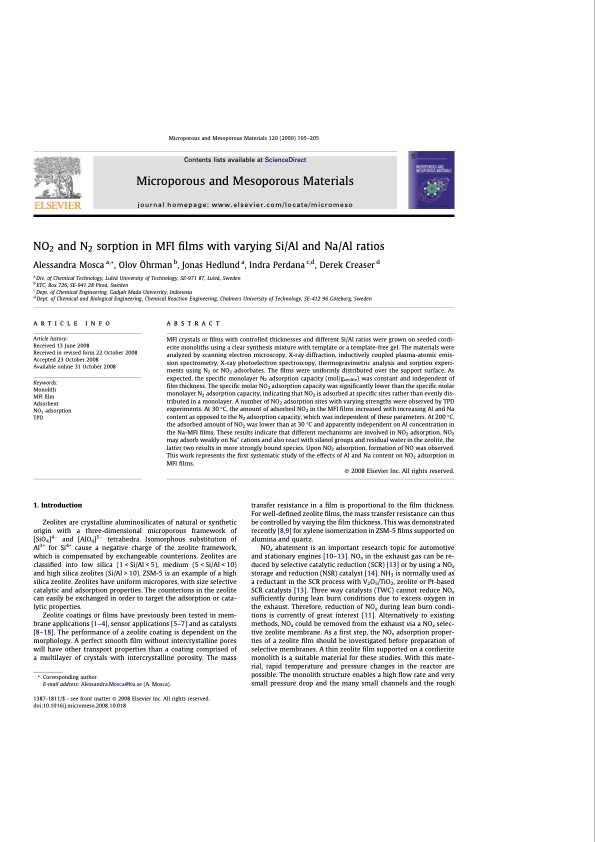
PDF Publication Title:
Text from PDF Page: 115
Microporous and Mesoporous Materials 120 (2009) 195–205 Contents lists available at ScienceDirect Microporous and Mesoporous Materials journal homepage: www.elsevier.com/locate/micromeso NO2 and N2 sorption in MFI films with varying Si/Al and Na/Al ratios Alessandra Mosca a,*, Olov Öhrman b, Jonas Hedlund a, Indra Perdana c,d, Derek Creaser d a Div. of Chemical Technology, Luleå University of Technology, SE-971 87, Luleå, Sweden b ETC, Box 726, SE-941 28 Piteå, Sweden c Dept. of Chemical Engineering, Gadjah Mada University, Indonesia d Dept. of Chemical and Biological Engineering, Chemical Reaction Engineering, Chalmers University of Technology, SE-412 96 Göteborg, Sweden article info Article history: Received 13 June 2008 Received in revised form 22 October 2008 Accepted 23 October 2008 Available online 31 October 2008 Keywords: Monolith MFI film Adsorbent NO2 adsorption TPD 1. Introduction Zeolites are crystalline aluminosilicates of natural or synthetic origin with a three-dimensional microporous framework of [SiO4]4 and [AlO4]5 tetrahedra. Isomorphous substitution of Al3+ for Si4+ cause a negative charge of the zeolite framework, which is compensated by exchangeable counterions. Zeolites are classified into low silica (1 < Si/Al < 5), medium (5 < Si/Al < 10) and high silica zeolites (Si/Al > 10). ZSM-5 is an example of a high silica zeolite. Zeolites have uniform micropores, with size selective catalytic and adsorption properties. The counterions in the zeolite can easily be exchanged in order to target the adsorption or cata- lytic properties. Zeolite coatings or films have previously been tested in mem- brane applications [1–4], sensor applications [5–7] and as catalysts [8–18]. The performance of a zeolite coating is dependent on the morphology. A perfect smooth film without intercrystalline pores will have other transport properties than a coating comprised of a multilayer of crystals with intercrystalline porosity. The mass * Corresponding author. E-mail address: Alessandra.Mosca@ltu.se (A. Mosca). 1387-1811/$ - see front matter Ó 2008 Elsevier Inc. All rights reserved. doi:10.1016/j.micromeso.2008.10.018 abstract MFI crystals or films with controlled thicknesses and different Si/Al ratios were grown on seeded cordi- erite monoliths using a clear synthesis mixture with template or a template-free gel. The materials were analyzed by scanning electron microscopy, X-ray diffraction, inductively coupled plasma-atomic emis- sion spectrometry, X-ray photoelectron spectroscopy, thermogravimetric analysis and sorption experi- ments using N2 or NO2 adsorbates. The films were uniformly distributed over the support surface. As expected, the specific monolayer N2 adsorption capacity (mol/gzeolite) was constant and independent of film thickness. The specific molar NO2 adsorption capacity was significantly lower than the specific molar monolayer N2 adsorption capacity, indicating that NO2 is adsorbed at specific sites rather than evenly dis- tributed in a monolayer. A number of NO2 adsorption sites with varying strengths were observed by TPD experiments. At 30 °C, the amount of adsorbed NO2 in the MFI films increased with increasing Al and Na content as opposed to the N2 adsorption capacity, which was independent of these parameters. At 200 °C, the adsorbed amount of NO2 was lower than at 30 °C and apparently independent on Al concentration in the Na-MFI films. These results indicate that different mechanisms are involved in NO2 adsorption. NO2 may adsorb weakly on Na+ cations and also react with silanol groups and residual water in the zeolite, the latter two results in more strongly bound species. Upon NO2 adsorption, formation of NO was observed. This work represents the first systematic study of the effects of Al and Na content on NO2 adsorption in MFI films. Ó 2008 Elsevier Inc. All rights reserved. transfer resistance in a film is proportional to the film thickness. For well-defined zeolite films, the mass transfer resistance can thus be controlled by varying the film thickness. This was demonstrated recently [8,9] for xylene isomerization in ZSM-5 films supported on alumina and quartz. NOx abatement is an important research topic for automotive and stationary engines [10–13]. NOx in the exhaust gas can be re- duced by selective catalytic reduction (SCR) [13] or by using a NOx storage and reduction (NSR) catalyst [14]. NH3 is normally used as a reductant in the SCR process with V2O5/TiO2, zeolite or Pt-based SCR catalysts [13]. Three way catalysts (TWC) cannot reduce NOx sufficiently during lean burn conditions due to excess oxygen in the exhaust. Therefore, reduction of NOx during lean burn condi- tions is currently of great interest [11]. Alternatively to existing methods, NOx could be removed from the exhaust via a NOx selec- tive zeolite membrane. As a first step, the NOx adsorption proper- ties of a zeolite film should be investigated before preparation of selective membranes. A thin zeolite film supported on a cordierite monolith is a suitable material for these studies. With this mate- rial, rapid temperature and pressure changes in the reactor are possible. The monolith structure enables a high flow rate and very small pressure drop and the many small channels and the roughPDF Image | Structured Zeolite Adsorbents for PSA Applications

PDF Search Title:
Structured Zeolite Adsorbents for PSA ApplicationsOriginal File Name Searched:
structured-zeolites.pdfDIY PDF Search: Google It | Yahoo | Bing
CO2 Organic Rankine Cycle Experimenter Platform The supercritical CO2 phase change system is both a heat pump and organic rankine cycle which can be used for those purposes and as a supercritical extractor for advanced subcritical and supercritical extraction technology. Uses include producing nanoparticles, precious metal CO2 extraction, lithium battery recycling, and other applications... More Info
Heat Pumps CO2 ORC Heat Pump System Platform More Info
| CONTACT TEL: 608-238-6001 Email: greg@infinityturbine.com | RSS | AMP |